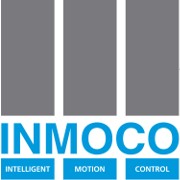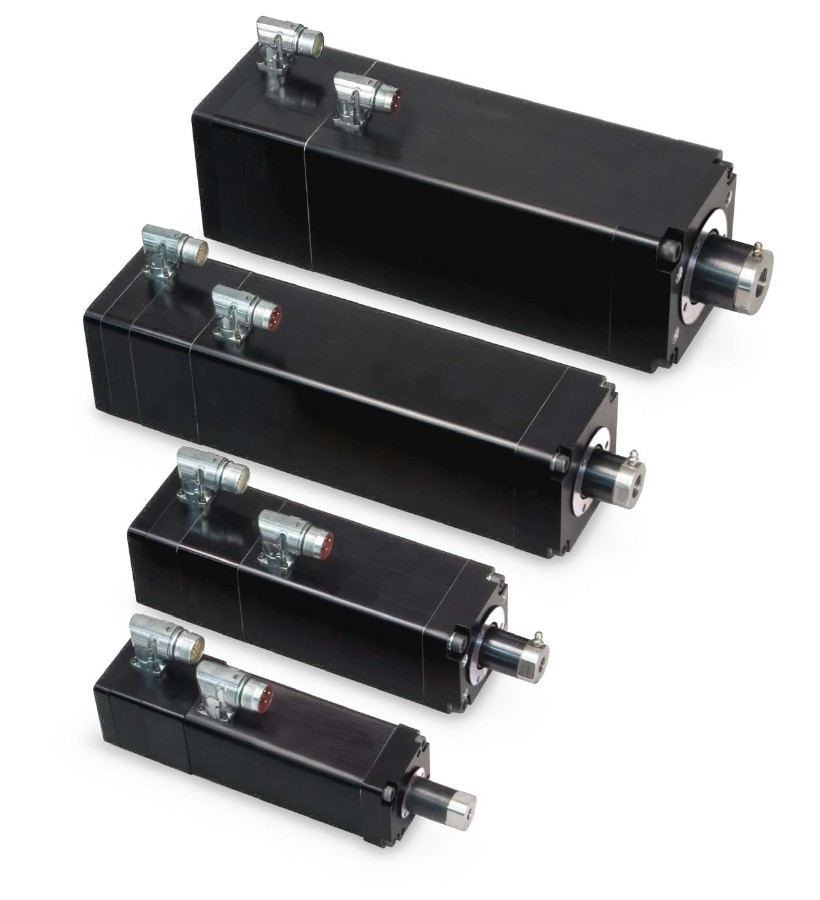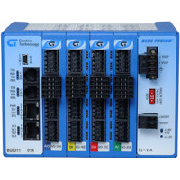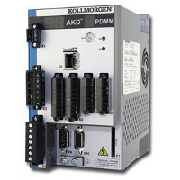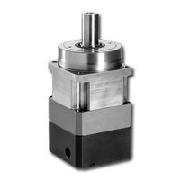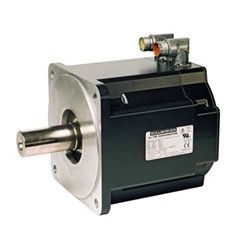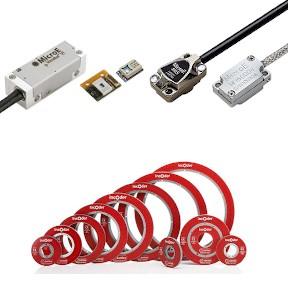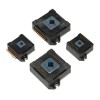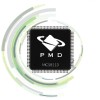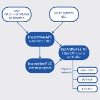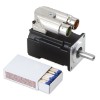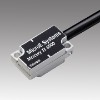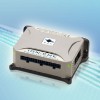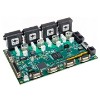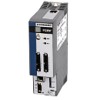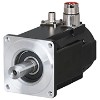Intelligent Motion Control Ltd (INMOCO)
For over three decades INMOCO has been at the forefront of Industrial Automation and Motion Control offering a comprehensive range of motion control products covering compact Servo Amplifiers, Position Controllers, Gearheads, Stepper Motors and Controllers, Linear Motors, Sensors, and Electric Actuators. More recent additions to the product range include High Precision Linear and Rotary Encoders.
Today, INMOCO not only provides products with application and after sales support, but can also incorporate those products into customer-specified electromechanical sub-assemblies, which also includes testing and calibration. These latest additions to our services not only enables our customers a "Plug and Run" solution, but also enables them to reduce their supplier base.
Our facilities include system engineering, ex-stock sales distribution, building and testing sub assemblies and a class 10,000 clean room facility.
-
Digital amplifier from INMOCO delivers multi-motor capability
28 September 2017Performance Motion Devices’ ATLAS® digital amplifiers available through INMOCO have long been able to control a user’s choice of DC brush, brushless DC and stepper motors, but the latest version of this highly compact amplifier delivers enhanced multi-motor capability; allowing the motor type to be programmed by the user with no board changes required. The result is even greater flexibility in the development of motor control applications.
With length and width of a paper clip in its smallest version, but power outputs up to 500W, ATLAS® digital amplifiers are suited to applications in medical equipment, laboratory automation, scientific instruments, general motion control, force (haptic) feedback and more. They can be used for direct control of motor torque or, in conjunction with higher-level controllers, for positioning and velocity applications.
ATLAS® digital amplifiers utilise PMD’s proprietary digital current control and switching technology for exceptional efficiency and quiet motor operation. Control features include user-programmable gain parameters, tracing of motion control performance parameters, field oriented control and I2t current management. With an advanced digital current loop, integrated parameter analysis, non-volatile memory, and high PWM frequencies, they are the ideal choice for low impedance or high speed motor requirements.
The digital amplifiers are available in two package sizes, with three power ratings (75W, 250W and 500W) and with an operating supply voltage range of 12-56V. ATLAS® amplifiers are internally powered by a single motor supply voltage and provide automatic protection from over-current, under-voltage, over-voltage, over-temperature and short circuit faults.
Additional features include Serial Peripheral Interface (SPI), that eliminates the need for analog ±10V torque signals. Digital SPI torque command with checksum ensures more accurate motor control. ATLAS® digital amplifiers also provide pulse and direction step motor operation.
About INMOCO
Established in 1987, INMOCO now offers an extensive range of motion control equipment including: compact servo amplifiers, position controllers, stepper motors, PLC controllers, linear motors, sensors, electric actuators and gearheads. INMOCO’s product portfolio is supported by extensive applications and technical expertise, in addition to customer-specified electro-mechanical development and sub-assembly services; including calibrating and testing in a class 10,000 clean room facility.
-
Expanding the horizons of motion control chips
16 August 2017Off-the-shelf motion control chips or integrated circuits (ICs) are highly flexible and can in fact be used to control many other types of system, as Gerard Bush of INMOCO illustrates here.
Motion control systems rely on changing the speed of one or more motors in order to achieve a given outcome. For instance, glue laying and profile following typically use two motor driven linear actuators set perpendicular to one another. If you activate just one motor at a constant speed, the result is a straight line movement in one direction. Activate both motors at the same speed and you get a diagonal straight line. Activate them both but keep changing their relative speed and you get a curving line that may be required for laying glue around the periphery of a large vinyl letter prior to mounting on a board to make a sign.
The glue laying curve is analog, that is to say it varies steadily rather than stepping from one discrete point or ‘value’ to the next. However, most modern motion control systems are based on digital controllers not analog ones and approximate curves by moving in small steps between set point values. This arrangement works well, and indeed is the foundation of most curve following motion control systems in use today.
The same principle of curve following, using a series of small discrete steps, can be applied to many other analog systems including pressure and temperature control. To understand how this may work we can look at an example in which a standard IC is used to control the pressure of a reaction chamber.
High accuracy pressure control is a common requirement for many physical processes in biochemical, semiconductor and process control industries. OEM machine designers need an off-the-shelf and cost-effective solution for both single and multiple chamber vessels that provides accurate PID (proportional, integral, derivative) control and flexible pressure control profiles. This can be achieved using a Magellan® PID controller IC, as available in the UK through INMOCO.
The Magellan® family of ICs is best known for providing high performance chip-based motion control. They are available in 1, 2, 3, and 4-axis versions and can be used with different types of motors (settable by the user’s software), including brushed, brushless DC, and stepper, and in systems as diverse as profile following, pick and place, robotic arms, laboratory and medical equipment. They are designed for demanding and precise applications and are equally at home on non-motion applications such pressure valve control and temperature monitoring.
The basic principle for pressure control of a reaction chamber is based on a linear pressure sensor that outputs an analog voltage, signal conditioning, an analog-to-digital conversion (A/D) circuit, a Magellan® PID controller IC, output signal conditioning and a voltage-controlled flow valve. A host PC or microprocessor is also needed to communicate to the PID controller IC and provide overall sequencing and control of the reaction chamber or chambers. The IC, rather than its usual duty of motor control, provides the pressure control profile generation and PID pressure control.
In a pressure control system, the IC receives a parallel-word input from the analog voltage after it is converted to a digital signal. Its output mode is used to create a command voltage to the valve using an SPI-input drive chip. (SPI or Serial Peripheral Interface bus is a synchronous serial communication interface used for short distance communication, primarily in embedded systems.)
It is possible to use several different types of valve control signals, such as 4-20mA and +/- 10V DC signals, the choice of which will dictate the SPI drive chip to be used.
The Magellan® IC's flexible architecture can be used to set a desired pressure, create pressure profiles with linear or parabolic ramps and/or set breakpoint conditions such as 'automatically change to a new target profile after a specified pressure set point is reached'.
The PID sample/output rate is adjustable and needs to be tuned to meet the needs of individual systems. For typical pressure controllers, this means setting the PID loop sample time to between 10msec and 1sec.
The Magellan® IC can also be used to control temperature. In fact, it is common to control both pressure and temperature in a single reaction chamber. This would take up two 'motion axes' of the Magellan® control IC. The principle of control is the same; the input sensor provides a real-time temperature reading and the output from the PID drives a heater/cooler. Further, in multi-chamber reaction vessels, ‘two axis’ control in each chamber is needed to provide temperature and pressure for the full system.
The Magellan® range of ICs offers solutions to many different requirements. For instance, the MC58113 is a single axis IC with an integral digital current loop and amplifier switch signal generation. It can provide positioning, velocity, and torque control of motors but is equally at home on other duties such as pressure and temperature control.
Thus we have seen that motion control ICs are in fact very flexible and can be used in a wide range of other control applications. The analog input signals normally relating to acceleration and deceleration speed changes can in reality be representative of many other process parameters. This flexibility of use has many advantages such as reduced parts holding and designers being able to use chips with which they are already familiar.
-
Incentive™ family of automation software components for powerful and comprehensive control
26 July 2017Powerful custom-designed control systems can be designed and built with the Incentive series of automation software components, developed in the US by Control Technology Corporation (CTC) and available in the UK through INMOCO of Daventry.
Advanced technologies bring many potential advantages to manufacturers looking to improve their production processes. CTC provides the flexibility to develop bespoke systems by offering a choice of platform, programming, networks and architectures. Its Incentive Software, for instance, runs on standard PC hardware. This can be married with CTC’s Series 5300 programmable automation controllers, with integrated motion, data handling and a powerful high-level language.
Designed to run on standard PC platforms, the main components in the Incentive family include:
• IncentivePLC – a multitasking control runtime system executing the powerful QuickBuilder automation language.
• IncentiveECAT – a high-performance EtherCAT master controller for direct control of EtherCAT devices from standard PC hardware.
• IncentiveAPI – a DLL (dynamic-link library) offering a high-level control API (application programming interface) for code written in C#, C++ or VB.Net.
“Incentive provides users a complete solution for high-performance PC-based control of automated industrial processes, whether for standalone equipment, motion control, or plantwide control architectures,” explains Gerard Bush of INMOCO.
Incentive has a real-time operating system (RTOS) that enables simultaneous operation of Windows 10 (or Windows 7) and one or more independent real-time processes. The system combines the responsiveness required of high-speed motion applications and the flexibility of a fully-featured operating system able to run vision systems, HMIs, data tracking and processing applications, and other high-level programs.
Incentive also provides data aggregation, enabling efficient interfacing with database applications. It has provision for network security and other functions necessary when transferring sensitive data.
IncentivePLC has the functionality of a programmable logic controller, so can replace hardware PLCs and create a truly open architecture.
IncentiveAPI provides an extensive API to interface your C#, C++ or VB.Net code to IncentivePLC and/or IncentiveECAT processes running either locally or remotely. In addition to supporting custom applications, this makes it easier to integrate vision systems, HMIs and other third-party subsystems into a system’s control architecture.
IncentiveECAT is a powerful software-based EtherCAT master controller that works in conjunction with IncentivePLC, IncentiveAPI or indeed both simultaneously. During initialisation, IncentiveECAT can scan the network to identify all the field devices in the system and automatically configure them for use.
The Incentive family of industrial control software joins CTC’s hardware offerings, featuring the Series 5300 programmable automation controllers, panel-mountable hardware solutions for both standalone and distributed control applications. With a wide range of high-density digital, analog and motion control modules available, and extensive data communications and networking capabilities, these systems can serve as the principal control system on even the most complex equipment designs, or as intelligent remotes.
“There is a growing list of vendors’ devices which are compatible with the Incentive series,” explains Gerard, “making it possible to select the most appropriate equipment for any given duty.”
-
INMOCO adds 24V options to AKM servomotor range
19 July 2017The benefits of permanent field servo technology - energy efficiency, durability, power density and overload capability - are now available to users of extra low voltage motors, via new units in INMOCO’s Kollmorgen AKM servomotor range. Originally available in 48V designs, the AKM range has now been extended to include 24V.
The AKM range of motors is wide, giving engineers a good choice of options to meet the needs of their applications. They are renowned for combining power and precision, adaptability and affordability.
The torque range of the AKM range is up to 1.25Nm (continuous) and 4.1 Nm (peak), with rated speeds up to 2500rpm. They provide up to 300W of power at a current of 6A, making them ideal for many tasks requiring exact high speed motion and precision control such as positioning, assembly and packaging. The motors’ ability to produce high peak currents, up to 15A, means breakaway torques and overloads can be accommodated without the need for an oversized unit.
The motors are available in three frame sizes, a compact 40mm flange diameter, a midsized 58mm and top of the range 70mm.
Like the existing AKM motors, the new 24V options have a power range up to 300W. They will extend the envelope of applications in which the AKM range can be used, typically being selected for lighter duties, such as label printing, vial filling and populating electronic boards, where a 48V motor may have been oversized.
Like the existing AKM motors, the new 24V variants can be used with a wide selection of feedback technologies and have all the benefits of permanent-excited servo drives. They are expected to be used to complement the larger 48V drives, thus will be an appropriate choice for some existing applications, as well as finding new uses.
-
Miniature encoders help advance surgical robot capabilities
17 May 2017The demands of robotic surgery, one of the most exciting and rapidly developing areas of medical technology, are encouraging motion control engineers to push the boundaries of their discipline. Gerard Bush an application engineer with INMOCO looks at one project where the humble encoder has reached new heights.
People have been practising medicine for literally millennia, but somewhere between 100 and 200 years ago it began to transform into a modern science grounded in rational thought and analysis. A key part of this advance has been the bringing together of different disciplines, such as anatomy and bacteriology. As the decades have progressed medicine has also come to rely more and more on technological developments. Specialist equipment varies from simple stethoscopes and thermometers to whole body CAT scanners and miniaturised implants.
One of the most exciting developments today is in robotic aids for surgeons. It is well-known that surgery was little different from butchery as recently as the great wars of the nineteen century, with post-operative survival rates being barely better than would be achieved with non-intervention.
Fortunately, the arrival of a new century saw surgery become far more systematic and effective. By then technological advances were able to reduce shock, trauma and bleeding so that surgeons could take enough time to bring some precision and consideration to their actions. However it remained reliant on the dexterity and manual skills of individual surgeons well into the second half of the century.
The next developments were cameras and optical systems that allowed the operating staff to see the area of operation far more clearly. And it is natural that from here there evolved a need for mechanical guides and manipulators to aid steady hand movement. Soon powered systems were developed, capable of producing movements of such precision that they could not be produced by a person, no matter how skilled or committed.
Thus we have seen the emergence of the surgical robot arm, a technology that stands to revolutionise surgery and healthcare in the coming decades.
The first time a robot was deployed in an operating theatre was in 1983 at the UBC (University of British Columbia) Hospital in Vancouver, where it was used to assist in an orthopaedic procedure. This was so successful that in the following 12 months over 60 arthroscopic surgical procedures were performed!
Another early development was a ‘theatre nurse’ robot which handed instruments to surgeons on voice command. Within a few years a robot had placed a biopsy needle into a patient’s brain using CAT scan guidance to achieve previously unimagined precision. Another pioneered new prostate surgery procedures at Guy's and St Thomas' Hospital, London.
By the year 2000, the rapidly accelerating power of computers was being twinned with robotics, giving them artificial intelligence equal to many years of human experience. Today robots are used in almost every area of surgery and provide, for instance, MR image-guided neurosurgical procedures, while real-time feedback technologies are redefining standards for minimally invasive surgery.
INMOCO supplies precision motion control technology and expertise to many fields of endeavour, including medical technology and robotics. It represents a number of international companies, including America’s Celera Motion, a leading manufacturer of miniature, high-performance linear and rotary optical encoders.
Producing the world's most innovative encoder technologies with its MicroE brand products, Celera Motion has driven innovations in the design of machinery, equipment and instrumentation in many industries, including industrial, robotics, automation, metrology, semiconductor manufacturing, packaging equipment, entertainment, energy, military, and scientific research.
In one project to develop a surgical robot arm, there was a requirement for an ultra small precision rotary axis control for multiple sequential robot arm joints. Additional requirements included minimal movement at start-up so that absolute position could be ensured, reduced signal cabling and compact overall arm size.
Recognising that the project demands could not be met with off the shelf products Celera Motion developed a series of custom-sized PCB-based encoder modules. Only 20mm diameter and 13.8mm high, they are fitted with FPGA (field-programmable gate array) control and BiSS (bidirectional/serial/synchronous) communication interfaces. Each has two standard MicroE ChipEncoder read-heads and a Micro Motion Absolute (MMA) rotary grating disk.
MMA grating technology employs a 40 micron pitch incremental counting track, coupled with a reference track from which each index is uniquely spaced. This gives a resolution of 85,280 CPR (counts per revolution).
With even the smallest movement at start-up, multiple index marks are detected, and the measured spacing is compared to a lookup table in firmware to determine the absolute position. Because each module is fitted with two read-heads their outputs can be averaged for improved accuracy when determining absolute position at start-up.
BiSS serial communication protocol allows each successive robot joint to be connected in a daisy-chain arrangement, rather than having dedicated bus cables for each axis. This, along with the small size of the PCB-based encoders helps reduce the overall size of the each joint. High speed serial communication (32MHz clock, 1µsec update rate) assures high robot responsiveness to the operator’s commands.
While a tiny super precision encoder is just one part the robot’s motion control system, it is playing a vital part in helping push forward the boundaries of surgical technology and healthcare excellence. Most experts say medical robotics is still in its infancy and many years of further development can be expected.
About INMOCO
Established in 1987, INMOCO now offers an extensive range of motion control equipment including: compact servo amplifiers, position controllers, stepper motors, PLC controllers, linear motors, sensors, electric actuators and gearheads. INMOCO’s product portfolio is supported by extensive applications and technical expertise, in addition to customer-specified electro-mechanical development and sub-assembly services; including calibrating and testing in a class 10,000 clean room facility.
-
Encoders step up to help miniaturise electronics
28 March 2017A tiny vacuum encoder is playing a big role in improving the throughput, quality and packing density of wire bonding machines, as used by manufacturers of micro-electronic devices. The MicroE Mercury II encoder by Celera Motion, as available in the UK from INMOCO, is one-third the size of other encoders - which it out-performs - yet is easy to install and set up.
As performance expectations for microelectronic equipment continues to grow manufacturers need to achieve denser wire bonding yet greater reliability, whilst also increasing throughput and reducing overall cost of ownership of the production machinery.
Microelectronics is essentially electronics on a micrometre-scale or smaller and includes transistors, capacitors, inductors, resistors, diodes etc. As the technology continues to develop components constantly decrease in size. But at reduced scales, imperfect bonding can lead to efficiency losses and adverse parasitic effects. Thus wire bonding quality needs to be constantly improved, whilst production equipment has to become faster, more compact and increasingly reliable.
In practical operational terms this means wire bonds need to be placed closer together and with a more consistent and predictable three-dimensional wire path. Higher placement accuracy is also required due to smaller bond pad size and increased pad density.
In order to achieve these ends, a wire bonder’s motion control system needs to have the best possible control of velocity, acceleration and the third order derivative of position (which is often called “jerk”), with high speed positioning, excellent repeatability and high resolution. The motion feedback encoders need to perform in a high electromagnetic interference (EMI) environment with good thermal stability, have long cable flex life and high reliability.
MicroE Mercury II encoders provide cost effective solutions to system designers seeking either an analogue or digital incremental encoder for their next generation wire bonders. The Mercury II MII6000 digital encoders offer excellent options for those wire bonder designs requiring encoder interpolation external to the motion controller. These user-programmable encoders offer high speed, robust noise immunity, 1.2nm resolution and long cable life. They boast a ±20nm cyclical error on glass scales for excellent velocity stability.
A programmable input filter helps to eliminate the effects of high frequency noise in the encoders as well. The sensor heads are compatible with both linear scales and rotary gratings, while for partial-rotation requirements MicroE can supply arc segments of the rotary gratings so that the system footprint is minimised.
Gerard Bush, one of INMOCO’s application engineers says the MicroE vacuum encoders are smaller, higher performance, faster to install, and easier to set up and align than any other encoder.
“They fit into very tight spaces and work in both linear and rotary applications. Vented and constructed with vacuum compatible materials they are designed for a 48 hour bake out at 150°C, while simple things like colour coded leads aid rapid installation.”
Technically the MicroE encoders have advanced electronics built into a shielded D-sub connector, and they are fitted with an LED alignment indictor. The output is A-quad-B with programmable interpolation in integer steps for resolutions to 0.005µm (linear); 67.1M CPR (rotary). Other technical specifications include external dimensions of 22.6mm x 12.7mm x 8.1mm and a weight of 3gms and a 20µm grating period.
“A bi-directional index signal and best-in-class noise immunity make them robust and easy to use,” says Bush.
“People marvel at how much electronics has developed over their lifetime. But most don’t realise that this has only been possible because of equal advances in manufacturing techniques – and that this has spun out many, many related technologies such as tiny yet precise encoders and other motion control equipment.”
About INMOCO
Established in 1987, INMOCO now offers an extensive range of motion control equipment including: compact servo amplifiers, position controllers, stepper motors, PLC controllers, linear motors, sensors, electric actuators and gearheads. INMOCO’s product portfolio is supported by extensive applications and technical expertise, in addition to customer-specified electro-mechanical development and sub-assembly services; including calibrating and testing in a class 10,000 clean room facility.
The image(s) distributed with this press release may only be used to accompany this copy, and are subject to copyright. Please contact DMA Europa if you wish to license the image for further use. -
Making more of motion control in packaging machine design
15 December 2016Packaging machine designs call for ever greater levels of performance and flexibility, combined with the ability for faster changeovers from one product run to the next, so engineers are making greater use of electronic motion control technologies. Gerard Bush of INMOCO (Intelligent Motion Control) looks at the opportunities and the challenges.
The level of automation within packaging lines has increased dramatically over recent years as end users have called for greater performance, the ability to handle smaller batch sizes, and rapid changeovers from one batch to the next. As customers look for ever greater customisation, packaging machines are required to handle a broader range of products, faster and more efficiently.
Electronic motion control has thus become critical to the design of such machinery. It can provide the ability to quickly change from one product batch to another simply by selecting from menus of different options. Further, electronic motion control has become an important aspect of virtually all functions of a packaging machine’s operation, including product sorting, portioning, enclosing, sealing and labelling – plus there is always the need to convey the products from station to station along packaging lines.
Operations will start with the correct sorting and portioning of products to be packaged. Where solid goods are concerned, we might be talking about products coming down a conveyor that need to be positioned ready for picking and placing. At the same time, designers might need to consider how any reject products will be dealt with. Options for sorting, directing or rejecting products could include everything from pick-and-place robots or XY tables at one end of the scale, down to mechanical flippers, pushers and spinners at the other.
Simple mechanical devices offer effective solutions for use with large batch runs of a single product. However, their lack of adaptability means they are not so good on machines that are required to be flexible enough to accommodate smaller batch runs or multi-product runs. Here an electronic solution is preferred because of the speed with which they can switch from one batch’s settings to the next.
Electronic motion systems can store operational menus for a host of different products, with changeover from one to another at the touch of a button, or even as directed automatically from a higher level system. Trapezoidal or S-curve velocity point-to-point moves can be readily programmed into the motion control system, or custom profiles can be quickly developed to replicate the functionality of mechanical cams, enabling different aspects of motion (position, speed and acceleration) to be controlled and synchronised.
On beverage lines, the portioning-of-products function is manifested as a liquid dispensing operation. This will have similar motion control aspects, but they will cover the control of pumps to dispense the required amount of liquid.
Alternatively, a packaging line might be fed from an extruder, requiring cutting of correct sizes of material from a continuous feed. This is most easily accomplished using a rotating knife, but even here there can be important motion control considerations. For example, the knife will need to be synchronised with the extruder speed, so that product portion size remains constant even if the extruder speed increases or decreases. This synchronisation can be readily accomplished using an electronic gear profile or with an electronic cam.
In some applications there may be benefit in looking at more sophisticated methods of handling the cutting of products from the material stock pieces, perhaps when two or more product sizes are required. Here XY tables or other placement processes synchronised to appropriate cutting technologies may offer a solution.
With the products dispensed, cut, sorted and positioned as appropriate, the next operation on the packaging line will be enclosing the products and sealing them. This might mean placing solid products into trays, cartons or boxes and closing those boxes up. The levels of machine flexibility required will determine the sophistication of the automation system from a motion control point of view. Simple mechanical systems might well be adequate, but increasingly picking and placing is being provided by Cartesian systems with defined motion profiles.
On food or liquid processing lines, operations might include applying caps to bottles or a film or foil cover. Motion control can be used to ensure that caps are secured to a set torque by running the amplifiers in electronic torque mode.
Film application, on the other hand, will typically be a web tensioning operation, which is a further motion control task – maintaining the web at a determined tension depending on the material feed rate and speed of the product on the conveyor. Options include simple control of mechanical dancer arms to simultaneously controlling both the supply and tensioning spool using electronic motion solutions.
The same considerations may need to be applied to the final sealing of the containers for the product batch, as multiple products are sealed into boxes, or multiple boxes are sealed into larger pallets.
As the packaged products approach the outfeed, a final operation will be the labelling of boxes or cartons. Where the application of the label is provided by a mechanism such as a moving arm, here, too, there are motion control considerations. Designers will need to look at how the speed of the labeller is synchronised to the conveyor speed (perhaps using electronic gears or cams), and how the arm deals with different sizes of products.
Thus we have seen that in all areas of packaging machine design, electronic motion control can deliver improved flexibility and performance. However, the designers and users of today’s high capability packaging machines typically do not want to use wall mounted controllers, as is often necessary with PLC-based solutions. Instead they prefer very small footprint motion control ICs and amplifiers that are ultra-efficient so that they can be directly integrated to the equipment frame.
INMOCO can supply Performance Motion Device’s (PMD’S) range of motion control ICs and amplifiers to meet the needs of high tech packaging machines. The PMD equipment is also equally well suited to other advanced applications that require both configuration flexibility and dynamic motion performance, yet can be easily configured and reconfigured to handle multiple motion control requirements.
About INMOCO
Established in 1987, INMOCO now offers an extensive range of motion control equipment including: compact servo amplifiers, position controllers, stepper motors, PLC controllers, linear motors, sensors, electric actuators and gearheads. INMOCO’s product portfolio is supported by extensive applications and technical expertise, in addition to customer-specified electro-mechanical development and sub-assembly services; including calibrating and testing in a class 10,000 clean room facility.
-
Advanced motion cards provide precise actuation on compact blood analyser
19 November 2016When a new design of compact blood analyser was being developed, a key challenge was to create an efficient and cost effective motion control architecture that could support multiple axes and multiple motor types while maintaining a table top format. The solution was provided by advanced motion cards and digital drives from PMD, which are available in the UK through INMOCO of Daventry.
The new analyser is a comprehensive all-in-one design, which includes an incubator station, sample and reagent holding station, pipette assembly, centrifuge, analysis station and transport assembly. Critical areas for control were identified as the centrifuge itself plus the transport assembly that carries containers between the incubator station, centrifuge and analysis station. There is also a motion control requirement for the pipette assembly which draws and dispenses samples, reagents and dilution fluids to produce solutions for testing.
All this calls for multiple axes of coordinated motion, including single-axis point-to-point operations, multi-axis point-to-point operations and velocity controlled rotation. For a compact and cost effective solution, the designers turned to PMD motion technology, using different motion card formats and digital drives to suit the needs of different parts of the machine.
PMD’s Prodigy motion cards are available in PC-104, PCI and standalone PCB configurations. Where compact size is the primary concern, a PC-104 format can reduce overall system size by using stacked motion cards mounted on the control system mother board. On the other hand, if a more distributed architecture is needed, a standalone format (with or without on-board amplifiers) can be used to mount the motion card within the various subsystems.
The blood analyser was well suited to individual cards and digital drives. The PMD Prodigy Machine Controller motion card was selected for the 2- and 3-axis arms in the sample storage carousel and incubator. Prodigy motion cards combine up to four amplifiers and a positioning controller on a single PCB, providing convenience and space saving as well as reduced assembly costs. The card controls the torque, velocity and position of a number of different motor types, including DC brushed, brushless and stepper motors.
Based on PMD’s industry leading Magellan motion processor, the Prodigy cards provide user-selectable profiles modes, including S-curve, trapezoidal, velocity contouring and electronic gearing. The cards accept parameters such as position, velocity, acceleration, either from the on-board C-Motion engine or from an external host to generate a corresponding trajectory on the fly. Servo loop compensation utilises a full 32-bit position resolution, and a PID loop with velocity and acceleration feed-forward, integration limits and dual biquad filters for sophisticated control of complex loads. A digital current loop utilising field oriented control gives users complete control over BLDC and DC brushed motors and seriously reduces noise in stepper motors.
The same card was used to meet the needs of the various transport systems throughout the machine, again enabling a high degree of flexibility in the design of different models of the unit. Further, the multi-motor support means that the designers could optimise motor selection in the system for both cost and performance.
For example, stepper motors were used in the 2- and 3-axis arms in the storage carousel, while brushless DC motors were fitted in the incubator. Motion functions for the handling of liquid and pump controls were incorporated in the design.
For the centrifuge, PMD recommended its ION digital drives – fully enclosed modules that provide high performance motion control, network connectivity and power amplification. PMD offers two output power choices, with the ION 500 rated at 500W and the ION 3000 rated at 3000W. Key features of the drives include their very high power density, ruggedness, and flexible form factor. They perform profile generation, servo compensation, stall detection, field oriented control, digital torque control and many other motion control functions.
In the centrifuge the ION digital drives operate in velocity profile mode with time break points. Using the velocity profile mode the centrifuge can be set up to run at various velocities at predetermined time points that match the specific process to achieve variable speed control and the resulting relative centrifugal force (RCF). In this mode the motion is controlled by changing the acceleration, velocity, and deceleration parameters while the profile is being executed.
The ION supports up to two break-points, and the trigger condition can be one of up to ten parameters. For this application the trigger condition is time, and at each trigger point the acceleration and velocity parameters are updated, and the next set of parameters loaded.
Motion control programming for the Prodigy motion cards and ION digital drive was simplified through the use of PMD’s C-Motion development suite, which includes an extensive library of proven motion control code as well as an array of development and debug tools. The powerful C-Motion command set reduced the development time for the C/C+ programs running the on-board host.
About INMOCO
Established in 1987, INMOCO now offers an extensive range of motion control equipment including: compact servo amplifiers, position controllers, stepper motors, PLC controllers, linear motors, sensors, electric actuators and gearheads. INMOCO’s product portfolio is supported by extensive applications and technical expertise, in addition to customer-specified electro-mechanical development and sub-assembly services; including calibrating and testing in a class 10,000 clean room facility.
-
Motion controller also handles automation functions
21 April 2016The Kollmorgen PCMM is a new motion controller which can also run automation and logic functions. Available in the UK from INMOCO of Daventry, it can co-ordinate up to 128 axes or fully synchronise 32 axes without the need for a PC.
The PCMM provides a compact yet powerful and cost-effective hardware platform which is ideally suited to modular or stand-alone machines that must combine flexibility with performance. Both the motion control and the automation functions are programmed in the standard IEC 61131-3 languages using the intuitive Kollmorgen Automation Suite’s Integrated Development Environment (KAS IDE).
The PCMM is plug-and-play compatible with Kollmorgen’s broad range of motion control solutions and has Kollmorgen Workbench integrated into it so that it can provide axis configuration and diagnostics.
At the heart of the PCMM is a powerful high speed CPU, which gives it the capabilities for use with a broad range of applications. There is also an alphanumeric display for easy set up and fast diagnostics and a removable SD memory card for simple file storage and reloading. The on-board digital I/O can be expanded via EtherCAT for high-performance motion and device synchronisation, while PipeNetwork can be used for visual programming of the motion requirements.
Interfacing the PCMM with a machine’s or plant’s wider control systems is via a 100BaseT connection, which supports TCP/IP, MODBUS, EthernetIP, Profinet, OPC, UDP and many fieldbus options.
The PCMM’s embedded real time operating system guarantees performance and stability, while an integrated web server gives remote diagnostics and status checking capabilities.
Even with all this capability the PCMM is compact in size making it easy and cost efficient to mount in a control cabinet, from where it can control multiple servo drives distributed around the machine or plant.
-
Servo motor with integral Ethernet interface can connect directly with CNCs
17 March 2016Servo motor with integral Ethernet interface can connect directly with CNCs
A servo motor range with an Ethernet-based interface, the DRIVE-CLiQ versions of the Kollmorgen AKM series, is now available from Inmoco, the Daventry based intelligent motion specialist.
These synchronous motors can be used directly for CNC applications with Siemens’ Sinumerik control in machine tools and other metal processing applications, without having to compromise in terms of the connection technology.
DRIVE-CLiQ is a special Ethernet-based interface for the Sinumerik control produced by Siemens. Originally it was only available on Siemens motors; later a special DRIVE-CLiQ sensor module was developed so that it could also be used with motors from other manufacturers.
However the module had the drawbacks of needing to be individually installed, which took time, required space in the control cabinet and increased the likelihood of mis-wiring and system failures. Now, however, by reading the field-specified commutation offset, the control system can automatically recognise the Kollmorgen motors. In many cases the existing cabling can continue to be used.
Inmoco uses single- and multi-turn 24 bit resolution feedback devices in DRIVE-CLiQ systems for high accuracy position resolution. This also creates the valuable safety feature of a single-encoder system that can be used for both monitoring and closed-loop functions.
The AKM motor series is available in eight standard frame sizes and 28 frame-stack lengths, with Inmoco offering the Drive Cliq option on sizes 4,5,6,7. It provides a comprehensive choice of voltage, feedback, braking and interfacing options; in fact there are more than 500,000 combinations of size and features offered across the range. Furthermore, its modular construction means bespoke specifications such as special windings, shafts, and mechanical/electrical interfacing are easily accommodated.
The AKM permanent magnet motors are recognised for their power density, high efficiency and low cogging characteristics, which ensure smooth dynamic performance with precise control and low energy consumption. They can be used with Inmoco’s AKD, S300 and S700 servodrives and thus provide plug and play operation for all centralised and decentralised Kollmorgen servo drives.

